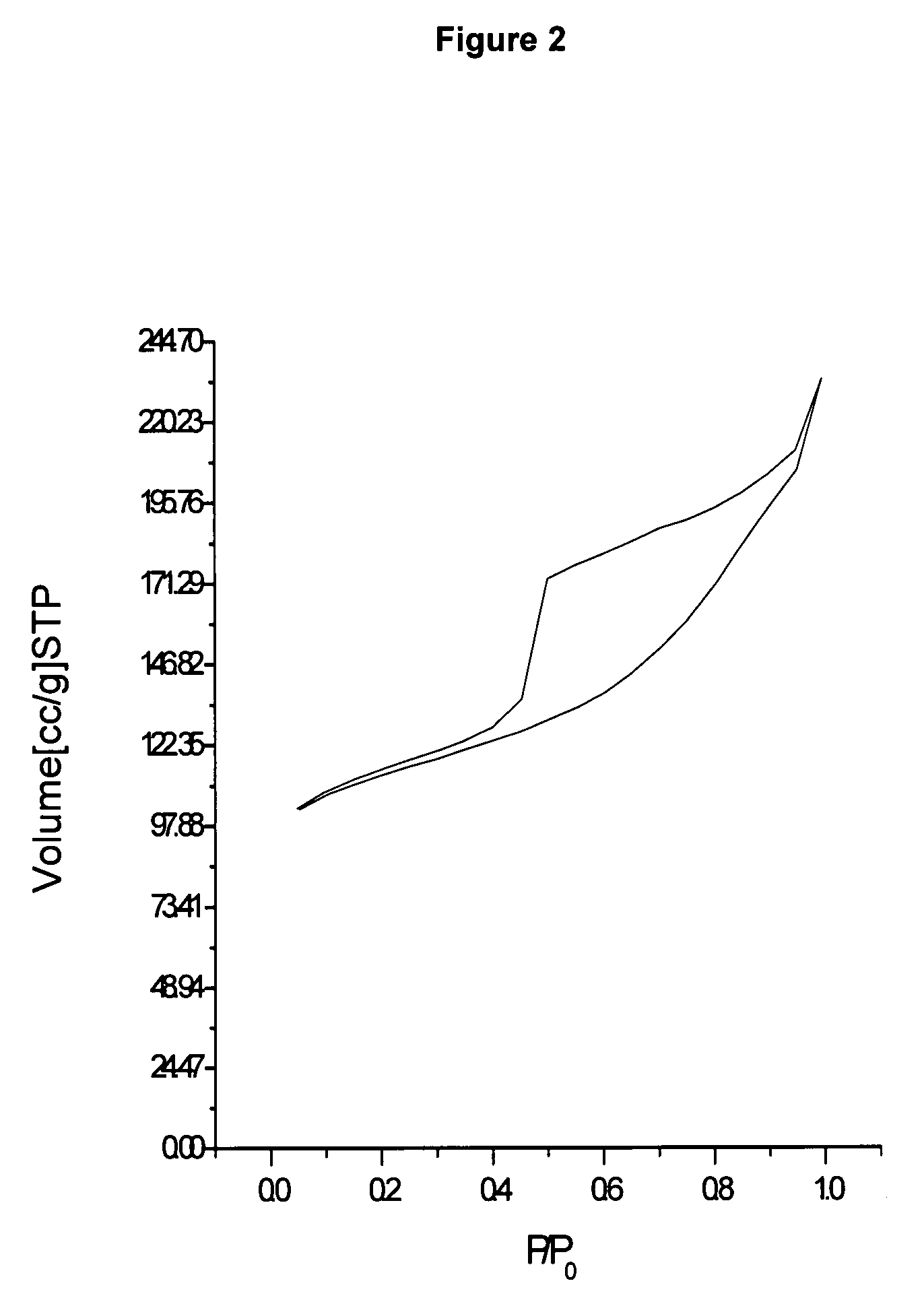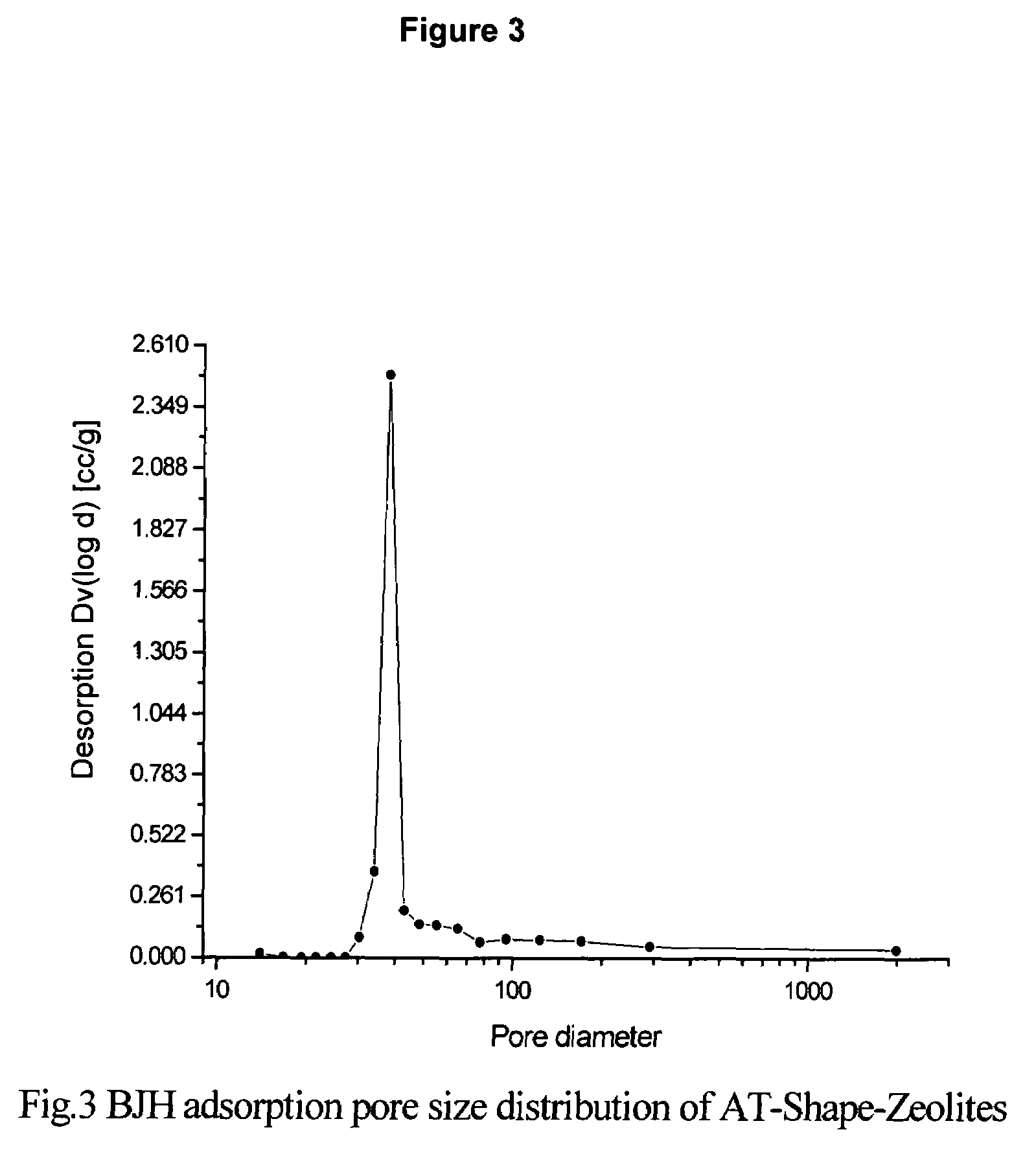Catalyst composition for treating heavy feedstocks
a technology of heavy feedstocks and catalyst compositions, applied in the field of heavy feedstock cracking, can solve the problems of difficult synthesizing a zeolite having an ultra-low framework si/al ratio, and the increase of the number of adsorption sites
- Summary
- Abstract
- Description
- Claims
- Application Information
AI Technical Summary
Benefits of technology
Problems solved by technology
Method used
Image
Examples
example 1
[0072]This example discloses the differences of product selectivity and yields between a catalyst made with alkali treated ZSM-5 (AT-ZSM-5, proton form) and the catalyst made using ZSM-5 which has not been alkaline treated but is in proton form (HZSM-5).
Catalyst 1
[0073]The catalyst uses HZSM-5 zeolite, AT-ZSM-5 zeolite and Beta zeolite as active components, clay as matrix, and aluminium sol as binder. A total of 8% (mass) of P2O5 is loaded on active components (zeolites) by ordinary incipient wetness impregnation technique. After loading the phosphorus the active components were dried at 120° C. for 2 hours and then calcined at 600° C. for 4 hours.
[0074]The catalyst components and preparation method are as follows: 38% (mass) of kaoline is added to 17% (mass) of alumina binder, stirring for 30 min, then the 45% (mass) of phosphorus loaded active components (it includes 33% (mass) of phosphorus modified HZSM-5 (SiO2 / Al2I3=40) zeolite, 45% (mass) of phosphorus modified AT-ZSM-5 zeolit...
example 2
[0082]This example discloses the differences of product selectivity and yields of the catalysts by using different phosphorus treating methods.
Catalyst 3 (Phosphorus Modification by In-Situ Hydrothermal Treatment Technique)
[0083]The catalyst uses HZSM-5 zeolite and Y-faujaste type zeolite as active components, clay as matrix, and aluminium sol as binder. A total of 8% (mass) of P2O5 is loaded by directly spraying diammonium phosphate ((NH4)2HPO4) water solution onto the hot active component at 680° C. in a rotary tube in 3 hours.
[0084]The catalyst components and preparation method are as follows: 48% (mass) of kaoline is added to 17% (mass) of alumina binder (sol), stirring for 30 min, then the 35% (mass) of active components treated by phosphorus hydrothermal treatment (it includes 55% (mass) of phosphorus modified HZSM-5 (SiO2 / Al2O3=40) zeolite, 45% of phosphorus modified USY zeolite (SiO2 / Al2O3=11)) are added to the solution, and the solution is mechanically mixed to form a homog...
example 3
[0092]This example discloses the differences of product selectivity and yields of the catalysts with TiO2 additive and the catalyst without TiO2 additive.
Catalyst 6 (with TiO2)
[0093]The catalyst uses HZSM-5 zeolite and Y-faujasite type zeolite as active components, clay as matrix, aluminum sol as binder, and TiO2 as an additive. A total of 8% (mass) of P2O5 is loaded on the active component (i.e. zeolite(s)) by ordinary incipient wetness impregnation technique.
[0094]The catalyst components and preparation method are as follows:
[0095]50% (mass) of kaoline and 10% of TiO2 (anatase) are added to 12% (mass) of alumina binder, stirring for 30 min, then the 28% (mass) of phosphorus modified active components (it includes 55% (mass) of phosphorus modified HZSM-5 (SiO2 / Al2O3=40) zeolite, 45% (mass) of phosphorus modified USY zeolite (SiO2 / Al2O3=11)) are added to the mixture, and the resulting mixture is mechanically mixed to form a homogeneous slurry. The slurry is dried at 120° C. for 2 ho...
PUM
| Property | Measurement | Unit |
|---|---|---|
| weight % | aaaaa | aaaaa |
| weight % | aaaaa | aaaaa |
| weight % | aaaaa | aaaaa |
Abstract
Description
Claims
Application Information
 Login to View More
Login to View More - R&D
- Intellectual Property
- Life Sciences
- Materials
- Tech Scout
- Unparalleled Data Quality
- Higher Quality Content
- 60% Fewer Hallucinations
Browse by: Latest US Patents, China's latest patents, Technical Efficacy Thesaurus, Application Domain, Technology Topic, Popular Technical Reports.
© 2025 PatSnap. All rights reserved.Legal|Privacy policy|Modern Slavery Act Transparency Statement|Sitemap|About US| Contact US: help@patsnap.com



